Video of Stafford Beer briefly explaining system feedback using a Watt Governor.
Stafford Beer published a book in 1972 entitled The Brain of the Firm in which he presented a neuro-cybernetic model of any enterprise conceived as a viable system. This model, known as the Viable System Model (VSM), was used in Chile’s transition to a new form of Government in a way that greatly improved the economy’s resilience and connected Allende and his citizens in an unprecedented way.
I believe the project carried out in Chile, which was an exercise in management cybernetics and variety engineering, is an interesting approach worth understanding in light of today’s available technology and the challenge of connecting top-down and bottom-up initiatives in sustainability which seem too often disconnected. To those already familiar with the model, you will see I take the liberty to use mind maps to represent it. It’s not exactly the standard way but as mind map tools are ubiquitous and the VSM requires nested structures, I ended up adopting a mind map style while respecting as much as possible the original representation artifacts.
Viability is central to the VSM as opposed to traditional organization models oriented towards maximizing shareholder value for an enterprise or GDP for a country. Viability can be understood in simple terms as remaining in business constantly adapting to changes in the environment.
All organizations can be seen as a system made of different interacting parts which are more or less autonomous. It is precisely the balance between autonomy and control mechanisms necessary to preserve a cohesive whole that is central to viability and the VSM.
The common representation of an organization today is still the infamous org chart. This representation of the firm remains influenced by reductionist thinking and is more useful in understanding existing silo mentalities than explaining how the organization actually works. You would have to turn to enterprise architecture to look for diagrams of the functioning enterprise but unfortunately, there tends to be a hijacking with EA which leads to diagrams focusing on systems and technology. On the other hand, the VSM isolates a finite number of fundamental blocks which will be present in any viable organization, regardless of its size. The presence of all these fundamental blocks will be a condition of its viability. The blocks are named using a simple numbering scheme from 1 to 5, i.e. System 1 to System 5.
A cybernetic look at the organization
To begin constructing a VSM, I begin drawing 3 blocks: the environment in which the organization exists, the operations or main activities of the organization which interact with the environment and the management that ensures the balance between the environment and its operation. Operations are made of autonomous activities that are essential for the organization to survive and define its very purpose. The environment comprises for example clients, suppliers, potential employees. Below is a nested representation of these elements.

As it is common in systemic thinking, connectedness of the blocks is essential. Note the V symbols of varying sizes which stand for variety or the number of states presented by the environment, operations and the management respectively. A viable system balances variety across these boundaries at all times with the help of connectors called amplifiers and attenuators. Think of these as mechanisms to cope with the discrepancy in variety when crossing over from one to another. Red directed arcs on the diagram represent an amplifier or an attenuator. The VSM contains a number of these amplifier-attenuator pairs which form homeostat and ensure the ultra-stability of the entire system.
But let’s return to the model. Identifying the operations in for a VSM model can sometimes be difficult but is essential. Systemic thinking commands the identification of parts, relationships but also purpose. This is where you’ll nail down the purpose. There are usually multiple operations and I will assume only two in further diagrams. Each operational activity or operation of the system has its own management which is referred to as System 1 in VSM terms.
Operations, which follow their own agenda, are bound to generate some tension (or oscillations) across the organization. Autonomous operations face constraints unique to their environment which further increases friction potential. It will usually be difficult for one operation to understand the issues of another one, which occasionally leads to conflict. If you’re a parent of two or more children, this will sound familiar (thinking family as VSM). A coordination mechanism is introduced to damp oscillations and balance the amount of variety existing between the operations. This coordination mechanism is referred to as System 2.

A simple System 2 example would be separators places at grocery stores to prevent cashiers from mixing items on the conveyor belt which belong to two different customers. It’s a simple convention which reduces possible friction at checkout. Another example is the use of web-scale identifiers which facilitate the integration of multiple platforms across the Internet. Other examples are schedules for school rooms, teachers and students or air traffic controllers for assigning runways to companies.
With System 2, we have introduced the first block of the meta-management. As it stands, there’s no block looking out for the interest of all operations as a whole. We introduce a new block which considers synergies among the various operations of the organizations and allocates resources. System 3 is the block which sees all operations as a whole and ensures inner coherence of the system. It has a complete and up-to-date model of all System 1 blocks. In VSM, its intervention at the operations level goes against autonomy and is considered with care. When it occurs, it should consist of support and help to operations whenever viability of the whole is threatened.
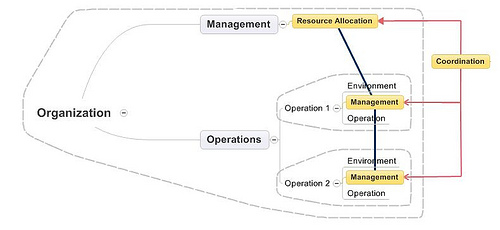
The model now exhibits two levels of recursion: the autonomous operations and the whole organization. Each is identified by a dashed line. A blue line links up operations to the meta-management. This link is bi-directional and transports reports up, instructions down. System 3 which focuses on here-and-now receives information over this vertical communications channel. But System 1 managers pass (via the blue line) the information that puts their interests in better light. System 2 also feeds System 3 with coordination information. This includes for instance controlling and planning data. These relations are not sufficient to keep variety between meta-management and operations in balance. To compensate, a new block is introduced which provides System 3 with direct access to System 1 operations for probing purposes.
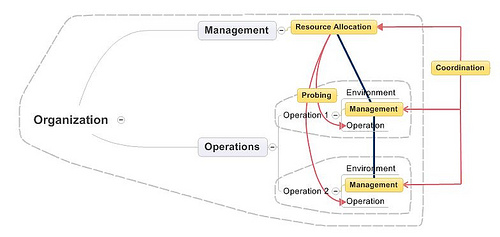
This block is referred to as System 3-star and occurs in organizations, for example, when you see senior managers walking through the plant having casual chats with one or the other members of the floor staff. Another example consists in involving of System 3 managers in operational projects. Think of it as a way to retrieve whatever information is missing to complete the model which is needed by System 3.
Now, how is the organization as a whole supposed to adapt itself to its environment? Operations, at a lower recursion level, deal with their specific environment only. A new block is introduced which deals with strategy and planning for the organization by looking out – it’s the then-and-there block of the model.
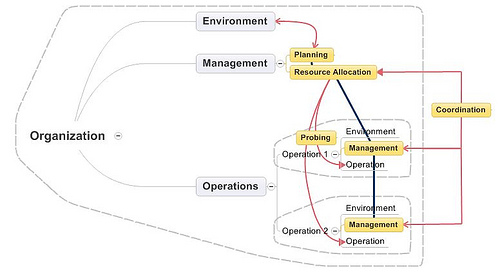
System 4 is typically the place in the organization where strategic management takes place, dealing with the unknown future. An example of this type of activity is Shell’s use of scenarios. Research and Development is another typical example of System 4 activity. System 4 operates within constraints set by System 3 while looking ahead at future scenarios. This relationship between System 3 and System 4 is not an easy one. Such different mindsets are required to handle here-and-now vs. there-and-then, that a last block is introduced to provide closure and stability: System 5.
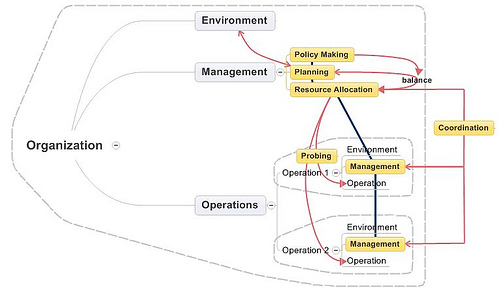
System 5 represents normative management and deals with policies, ground rules, values. For enterprises, this corresponds to shareholder or owner meetings.
The complete model with the original numbering is shown below in mindmap notation.
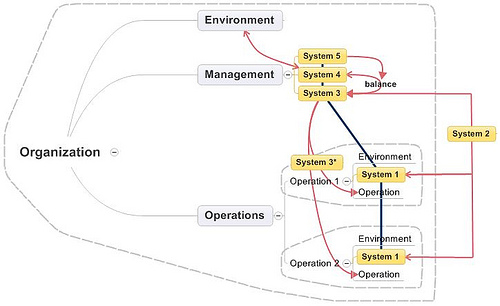
Cybernetic praxis in Chile
November 1971. Dr. Salvador Allende becomes president of Chile facing a complex situation: only 20% of the agrarian reform implemented, rapid wave of nationalizations, enterprises managed by transient leaders (interventors), a significant political opposition, blockade of spare parts preventing agriculture from functioning normally, food shortages, blockade on exports (copper) and finally blockade of foreign credit… A grossly unstable situation in Beer’s terms. Allende’s team had already been convinced that cybernetics had a relevance to their problems of society and government and the question outstanding was:
How should cybernetics be used in the exercise of national Government?
Project Cybersyn (Proyecto Synco in Spanish) was recently revisited by Eden Medina, Assistant Professor from Indiana University’s School of Informatics. Her peer-reviewed article “Designing Freedom, Regulating a Nation: Socialist Cybernetics in Allende’s Chile” won the 2007 IEEE Life Member’s Prize in Electrical History.
Below is a representation of the VSM, using mind map notation, of the VSM applied to a select number of recursions for Chile in the context of Allende’s government. It shows in yellow callouts a number of sub-projects which show that Cybersyn was only one component of the architecture put forward by Beer for Chile’s transition to a more stable situation.
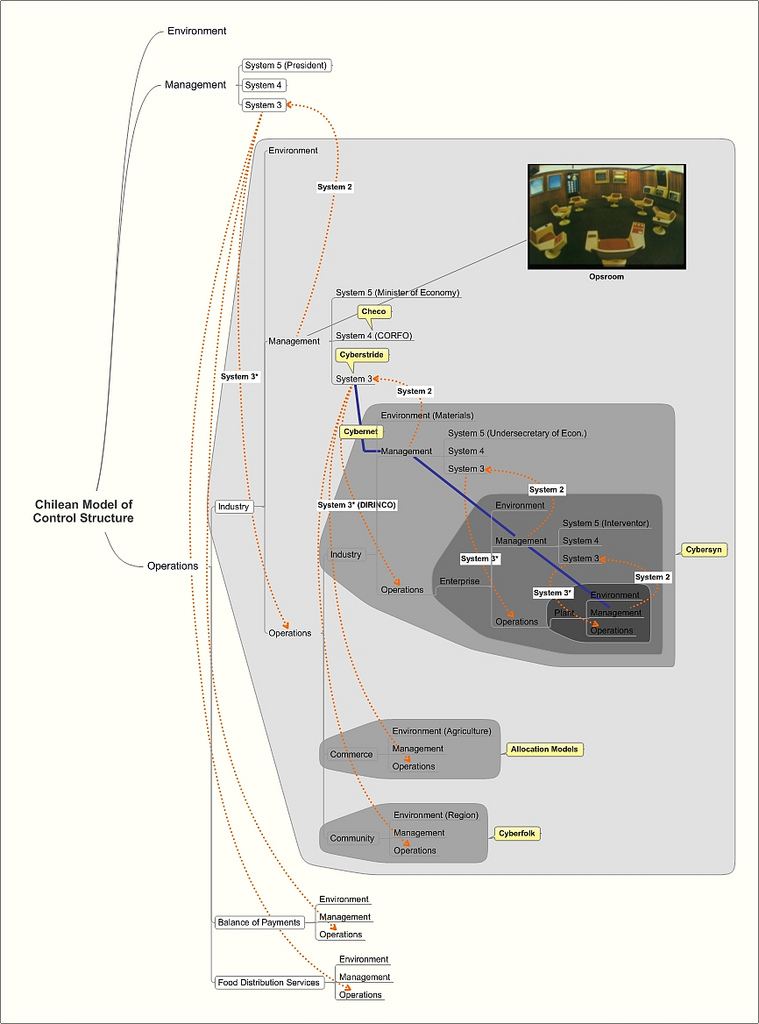
The scope of Cybersyn was the industrial sector of the economy and rested on other sub-projects:
- Cybernet
- consisted in a network made of telex machines spread across the nation feeding a mainframe in Santiago (today: Internet, cell phones, Arduino. It transported a number of key performance indicators (KPIs) to the custom software referred to as Cyberstride.
- Cyberstride
- was a Systems 1-2-3 software (1) computing a set triple-index measurements of all the KPIs transmitted by Cybernet (2) implementing a Bayesian filtering technique to discard noise and identify pertinent outliers and (3) providing a timed-trigger mechanism of escalation from one level of recursion to the other, e.g. from the plant to the enterprise or the enterprise to the group of enterprises in a branch.
- Checo
- was a System Dynamics program based on DYNAMO to simulate the Chilean economy (today Stella, Vensim or AnyLogic perhaps) which addressed System 4 needs and received, after filtering, triple-index information from Cyberstride.
- Opsroom
- a physical room implementing a number of interactive systems for CORFO including Staffy (VSM visualization), an exceptions and algedonics display (Cyberstride), a datafeed, Futuro (the Checo model) and support screens.
Cyberfolk was another project next to Cybersyn which tackled the participation of people in the context of the newer broadcast Television technology. It consisted of a push-button device providing real-time feedback from homes to the representatives of the government speaking on TV. This was only tested in a small circle though. Today, we might think of Twitter’s use in the Iranian upheaval – a sideband channel to traditional media which is capable of conveying pain or pleasure signals (algedonics).
What were the outcomes of these projects? Well, first of all, there was a Coup d’Etat in Chile. If you missed the movie Missing, this might be a good video rental idea to review the events in 1973. Before going down through the cracks of time, the team was able to draw some conclusions from the their hard work. Parts of Cybersyn related to regulation (Cyberstride) helped contain a truck drivers strike which would affect supplies. It was rapidly detected and countered by CORFO thanks to the triple-index transmission and escalation chain. As a whole though, Cybersyn seems to have met serious hurdles: structural changes were required for a proper use of the new tools and the models were not flexible to cope with the complex transition the country was undergoing. If you follow the progress of social network platforms within the orgainzation, you will related to the first issue. The success of social network platforms are tightly linked to enterprise culture and produce little results if the structures are not ripe. The second limitation related to models is a common critique of those who place too much faith in technology and science to resolve matters which are perhaps better resolved by a combination of human intelligence and technology.
Cybernetics in today’s crowdsourcing world
Stafford Beer was a brilliant man. Not easy to follow though… I find myself re-reading sections of the Brain or the Heart of Enterprise as I think of his ideas in the context of sustainability and sustainable development. I am definitely still only a student of this subject. But I’m not alone.
Last year, at the Berkman Center, Medina presented her research on Project Cybsersyn to the Harvard-MIT-Yale Cyberscholars working group. Patrick Meier, PhD candidate at Tufts University and author of the iRevolution blog attended and was stunned by what he learned and wrote a post about it on his blog. Who is Patrick Meier? No other than the guy that was instrumental during the Haiti earthquake in leading the use of Ushahidi with a team of students from several universities, manning a 24x7 operations center – the Ushahidi-Fletcher Situation Room. This is no coincidence to me.
Ushahidi is a crowd-sourced operations room. Instead of using telex machines to gather data, it uses cellular phones. The problem it addresses is that of a high variety situation of crisis which requires a prompt and accurate response. Nevertheless, the beauty of the Ushahidi approach during the Haiti response was that it is not based on a high-touch technology solution: SMS messages were submitted to people who processed the information. While this solution might not scale indefinitely, it represents to me a balanced approach between the use of modern technology and human intelligence to tackle a complex situation. Another interesting approach in that respect is Smallrivers’ paper.li which publishes crowdsourced newspapers based on Twitter timelines. These approaches are clever in mixing the right amount of technology with people’s ability to focus on a common purpose. I believe they are starting point to explore the architecture of innovative services in sustainable development which face tremendous levels of complexity. Beer’s work in management cybernetics raises valuable questions when designing crowdsourced solutions spanning multiple levels of governance.
In other words, what would Beer have thought of the Haiti response approach to crisis management?
 This material is licensed under CC BY 4.0
This material is licensed under CC BY 4.0
